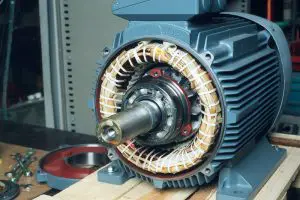There is no single electrical equipment that does not depend on insulation material.
An example of this is a short circuit and this should always be avoided. This is done by using proper insulation wherever there is a current or voltage
 |
There are four main areas where insulation must be applied.
They are follows
(1) between coils and earth (phase-to-earth),
(2) between coils of different phases (phase-to-phase),
(3) between turns in a coil (inter-turn), and
(4) between the coils of the same phase (inter-coil).
There are three main categories of insulating materials, gases, liquids and solids. The insulating materials are classified mainly based on their thermal capability.
The performance of the insulation depends on its operating temperature. The higher the temperature, the higher will be the rate of its chemical degradation, and hence the lower will be its operating life.
if life of insulation is expected long, its operating temperature must be maintained low i.e in it’s operating range. Therefore, it is necessary to determine the limits of temperature for which insulation, will ensure safe operation over its expected life.
Thus the insulating materials are divided into different classes O, A, B, and C.
What are types of insulation/ classes of insulation, uses and temperature range:
etc. formerly O
Insulation Class A: 105°C
Class A insulation consists of materials such as cotton, silk and paper when suitably impregnated or coated or when immersed in a dielectric liquid such as oil. Other materials or combinations of materials may be included in this class if by experience or tests they can be shown to be capable of operation at the Class A temperature
Insulation Class B: 13O°C
Class B insulation consists of materials or combinations of materials such as mica, glass fibre, asbestos, etc., with suitable bonding, impregnating or coating substances.
Insulation Class C: Above 18O°C
Class C insulation consists of materials or combinations of materials such as mica, porcelain, glass, quartz with or without an inorganic binder . Other materials or combinations of materials may be included in this class ,Mica, fibreglass (alkali free alumino borosilicate), bitumenized asbestos, bakelite, polyester enamel
Insulation Class E: 12O°C
Polythylene,terephthalate , cellulose,triacetate, polyurethanes.
Insulation Class F: 155°C
As class B Mica, fibreglass , bitumenized,asbestos, bakelite, polyester enamel. but with alkyd and epoxy based resins.
Insulation Class H: 18O°C
Class H insulation consists of materials such as silicone elastomer and combinations of materials such as mica, glass fibre, asbestos etc.
As class B with silicone resin binder, silicone rubber, aromatic polyamide, polymide film and estermide enamel.
practice, certain differentials are allowed because of the over loads, other manufacturing advantages and economics.
Uses of insulating material in various equipment:
APPLICATIONS OF INSULATION IN POWER TRANSFORMERS:
Transformers are the first to faced lightning and other high voltage surges. The
transformer insulation has to withstand very high surge voltages many times the
power frequency operating voltages. The transformer insulation is mainly divided
into:
- conductor or turn-to-turn insulation,
- coil-to-coil insulation,
- low voltage coil-to-earth insulation,
- high voltage coil-to-low voltage coil insulation, and
- high voltage coil-to-ground insulation.
APPLICATIONS INSULATION IN ROTATING MACHINES
Classes Y and C insulation find no application in rotating machines. Class E which was widely used in low voltage machines for over 20 years is now replaced by class F which is useful for the high voltage machines.
Also,Class F is widely used in place of class B. Considerable development has been done in recent years, in reducing the size of the electrical machines by use of class H materials, particularly, for small machines. however,the class H materials silicones, teflon is very expensive , and hence they are used only in traction motors and mill motors.
